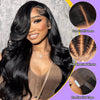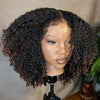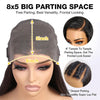Wigs VS Weaves VS Extensions: What Are The Differences Among Them?
Wigs, weaves, and extensions are three popular choices among beauty enthusiasts, which can provide you with a natural, seamless, and glorious appearance.
You may have heard of these three products before, but you don’t know the exact differences among them.
The following blog will explain the differences among wigs, weaves, and extensions in detail, which can help you better distinguish them.
What’s more, you will also learn how to choose among them, and save money and energy.
1. What is a Wig?
A wig refers to a hairpiece that covers the entire head, which is designed to cover the hair loss or baldness, or as a transformation for those who want to change their hairstyles or hair colors without making too much commitment.
For example, if you want to switch up your hairstyles but don’t want to dye or cut your natural hair, a wig is a suitable and wonderful choice for you.
Generally speaking, a wig is made of synthetic hair or natural human hair, which can totally cover your head.
In the wig industry, a synthetic wig is more affordable and cost-effective than a human hair wig, for it is made of synthetic fibers.
As we all know, synthetic fibers are far cheaper than real human hair.
However, a synthetic hair wig is less natural and durable than a human hair wig.
If you prioritize a natural and seamless appearance, you’d better choose a human hair wig.
Although a human hair wig is more expensive than a synthetic hair wig, it can blend naturally and seamlessly with your hair, giving the illusion that the hair is growing out from your scalp.
What’s more, compared to a synthetic hair wig, a human hair wig is famous for its versatility in styles, allowing you to restyle your hair with heated tools based on your demands and preferences.
With the development of human hair wigs, there are more and more options for you to choose from, including lace front wigs, hd lace wigs, wear-to-go wigs, and so on.
If you want to learn more about lace wigs, you can read this blog to get more information.

2. The benefits of a wig:
(1)Protective hairstyle.
First of all, a wig is a protective style that can protect your natural hair from damage, such as sunlight, rain, and so on.
What’s more, the heated tools can also do harm to your natural hair.
If you want to change hairstyles or colors without too commitment, a human hair wig is a wonderful choice for you.
(2)Convenience.
Secondly, it is convenient for you to change your hairstyle with a human hair wig.
Available in various kinds of human hair wigs, you can change your hairstyle quickly and easily, without too much commitment of time.
(3)Boost your confidence.
Just as it has been mentioned before, a wig is designed to cover hair loss or baldness.
That is to say, a human hair wig can provide you with a natural, authentic, and glorious appearance, which can boost your confidence and embrace your beauty.
(4)Versatility in styles.
Last but not least, a human hair wig is also versatile in styles, allowing you to restyle your hair with heated tools based on your demands and preferences.
3. The drawbacks of a wig:
(1)Uncomfortable.
Sometimes, a wig may cause some discomfort and irritation on your scalp.
For example, a synthetic hair wig is not breathable and comfortable for you to wear for a long period.
(2)Insecurity.
Secondly, if you use glue or gel to install your wig in the wrong way, the wig can not achieve a secure and snug fit, which will cause it to slip from your head.
(3)Time-consuming.
Generally speaking, you can not put on your wig when sleeping, showering, or swimming, so you’d better remove the wig during these moments.
What’s more, the installation and removal of a wig will also be time-consuming.
(4)Hair damage.
Last but not least, if you wear a wig for an extra-long period, it will cause some damage to your natural hair.
4. What is a Weave?
A weave refers to a basic type of hair extension that involves weaving, stitching, or sewing, which is attached to your natural hair to achieve your desired length and volume.
Generally speaking, a weave is attached to your natural hair by a needle or a thread, providing a natural and seamless appearance for you.
What’s more, you’d better turn to a professional stylist for help if you don’t know the right procedures for installing a weave, in case you cause damage to your natural hair.
In conclusion, a weave is suitable for you to choose, for it can last up to several months without too much care and maintenance.

5. The benefits of a weave:
(1)Change your hair length and volume.
First of all, as a weave is attached to your natural hair by weaving, stitching, or sewing, it can change the length and volume of your natural hair, catering to your natural demands and preferences.
(2)Low maintenance.
Secondly, a weave is low maintenance, which doesn’t require too much maintenance.
That is to say, once a weave is attached to your natural hair, it can last up to several months without too much care.
(3)Natural and seamless appearance.
Thirdly, a weave can blend with your natural hair naturally and seamlessly, providing you with a realistic and authentic appearance.
(4)Protective hairstyle.
Just like a wig, a weave is also a protective hairstyle, which can protect your natural hair from daily styling and environmental damage.
6. The drawbacks of a weave:
(1)Potential damage.
Firstly, if you install a weave in the wrong way, it will cause some potential damage to your natural hair.
(2)Time-consuming.
Secondly, the installation of a weave will be time-consuming, which means you may sit in the salon for a long time.
(3)Expensive.
Lastly, a weave is usually expensive, and the price varies depending on the different type and quality.
Besides, turning to a professional stylist for help will also be expensive.
7. What are Hair Extensions?
Hair extensions refer to bundles or wefts attached to your natural hair with clips, tapes, glues, or sew-in, in order to achieve the desired length and volume.
Generally speaking, extensions are available in various types and sizes, such as clip-in hair extensions, microbeads, tape-in hair extensions, fusion hair extensions, and so on.
To tell the truth, all the weaves are hair extensions, but not all hair extensions are the weaves.
What’s more, according to different installation methods and types, hair extensions have different lasting times.
In conclusion, a hair extension is a suitable choice for you to increase the length and volume of your natural hair.

8. The benefits of an extension:
(1)Protective hairstyle.
Just like a weave, a hair extension is also a kind of protective hairstyle, protecting your natural hair from daily styling and environmental damage.
(2)Low maintenance.
Secondly, a hair extension is low maintenance, which doesn’t require too much care and maintenance.
(3)Versatility in styles.
Generally speaking, hair extensions are versatile in styles, allowing you to restyle your hair according to your demands and preferences.
9. The drawbacks of an extension:
(1)Potential damage.
If the installation or removal of hair extensions is done incorrectly, it will cause some damage to your scalp and natural hair.
(2)Time-consuming.
Secondly, the installation of hair extensions will be time-consuming, requiring you to sit in the salon for a long period.
(3)Expensive.
Just like weaves, hair extensions are also expensive, for they can not be reused.
What’s more, visiting a professional stylist also costs you some money.
10. What are the differences between a wig and a weave?
When talking about the differences between a wig and a weave, the essential and primary difference is the coverage, which leads to a series of differences between them.
The following part will explain the differences between them from four main aspects in detail, making a systematic and comprehensive comparison for you.
(1)Coverage.
First and foremost, the coverage between a wig and weave is different.
A wig can cover your full head, while a weave only involves sewing or gluing hair extensions to your natural hair.
(2)Installation and removal methods.
Secondly, the installation and removal methods between a wig and a weave are different.
For example, you shall comb your hair first, then put on a wig cap, and finally, you can put on the wig.
If you want to learn more about the installation of a wig, you can read this blog to get more information.
As it has been mentioned before, the weaves are attached to your natural hair by weaving, stitching, or sewing.
(3)Price.
Generally speaking, a weave is more expensive than a wig.
What’s more, turning to a professional stylist also costs you some money, in order to achieve a natural and seamless appearance.
(4))Lifespan.
A wig has a longer lifespan than a wig, which is more durable and long-lasting.
Generally speaking, a synthetic hair wig can last about six months, and a human hair wig can last six months to one year with proper care and maintenance.
Usually, a weave can last six to eight weeks, which is less durable than a wig.
11. What are the differences between a weave and an extension?
When talking about the differences between a weave and an extension, the essential and primary difference is the installation process, which leads to a series of differences between them.
The following part will explain the differences between them from three main aspects in detail, making a systematic and comprehensive comparison for you.
(1)Installation process.
First of all, the installation process of a weave and an extension is different.
Usually, a weave is attached to the hair by weaving, stitching, or sewing, while an extension is attached to the hair with clips, tapes, glues, or sew-in.
Therefore, all the weaves are hair extensions, but not all hair extensions are the weaves.
(2)Versatility and flexibility.
Secondly, a hair extension is more versatile and flexible than a weave in styles, allowing you to change your styles daily.
(3)Maintenance.
Last but not least, a weave requires more maintenance than a hair extension, including regular washing and touch-ups.
12. How to choose among a wig, a weave, and an extension?
When deciding among a wig, a weave, and an extension, it depends on your budget and demands.
For those with a tight and limited budget, a weave or an extension can combine practicality and comfort perfectly, which is a cost-effective choice for most people.
If you prioritize performance and lifespan, a wig is a more suitable choice for you, because of its wonderful versatility and flexibility.
The following part will make a comparison among them from five main aspects, helping you make a better choice.
(1)Budget.
First of all, you should make the choice according to your budget.
If you have a tight and limited budget, maybe a wig is a more cost-effective choice for you.
If you have a sufficient budget, you can make a choice among them freely.
(2)Lifespan.
Generally speaking, a wig has a longer lifespan than a weave or a hair extension.
If you pursue a long lifespan, a wig is a more suitable choice for you.
(3)Maintenance.
Generally speaking, a wig requires more maintenance than a weave or a hair extension.
If you don’t have enough time to maintain your hair, a weave or a hair extension is a more suitable choice for you.
(4)Versatility and flexibility.
A wig and a hair extension are more versatile and flexible than a weave in styles, allowing you to restyle the hair daily.
If you prioritize versatility and flexibility, a wig or a hair extension is more suitable for you.
(5)Your demands and preferences.
Last but not least, you should also take your personal demands and individual preferences into consideration.
Conclusion:
After reading this blog, you must have a more comprehensive and systematic understanding of wigs, weaves, and extensions, which can help you better distinguish them.
In conclusion, when you make a choice among them, you should not only consider the budget, lifespan, maintenance, versatility, and flexibility but also take your demands and preferences into account.
It’s my pleasure if this blog can really address your concerns and problems about wigs, weaves, and extensions.
If you have any questions about human hair wigs, please feel free to leave a comment, and I will respond to you as soon as possible.


















































Leave a comment